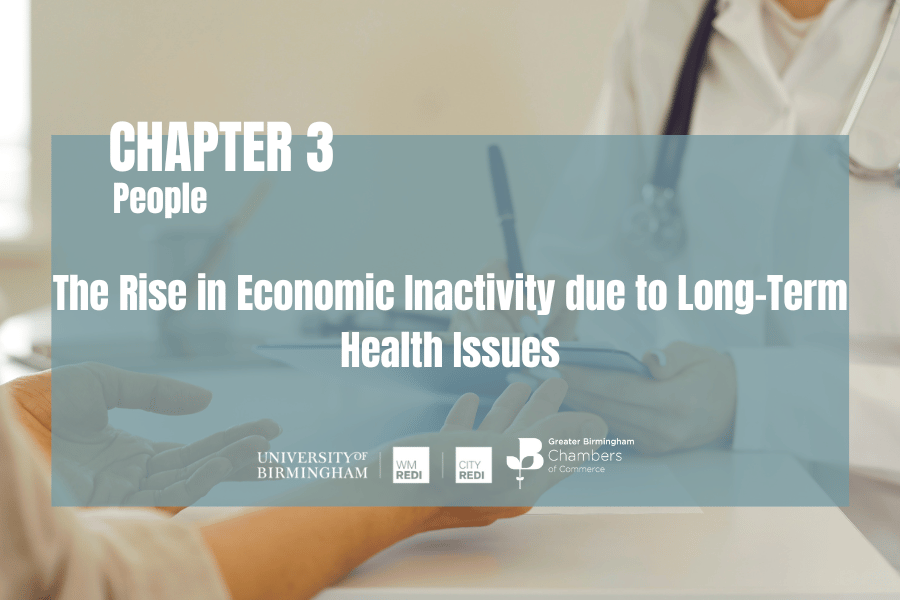Dr Justin Varney, Director of Public Health, Birmingham City Council discusses how retention of staff is key to the health and wealth of Birmingham and the wider region, as well as business.
This article was written for the Birmingham Economic Review, published in September 2023.
The review is produced by City-REDI / WMREDI, the University of Birmingham and the Greater Birmingham Chambers of Commerce. It is an in-depth exploration of the economy of England’s second city and a high-quality resource for informing research, policy and investment decisions.
Although some may think that it is an employer’s market at the moment, the ratio between vacancies and the number of unemployed people remains tight at a national level, and businesses feel this, especially at the highly skilled experienced end of the market.
Costs for a replacement
The estimated cost of replacing an experienced member of staff varies depending on lots of assumptions, using a recruiter, the cost of training advertising and the multiple elements of opportunity costs from the staff time involved in the recruitment to the loss of productivity during the transition. All of this adds up and impacts the business and its return.
At the same time, many employees post-pandemic are reflecting on their lives. Spending the last couple of years under variable safety restrictions with more home time has led to a shift in values and expectations of employers and what a good working environment and work-life balance look like.
So what does this have to do with health?
Over the last three years, there has been a progressive and steady rise in the number of people who are no longer economically active due to long-term health issues. In Birmingham, between April 22 – March 23, over 50,000 people were registered as unable to work due to health issues, an increase from about 36,000 in 17-18 for the same period.
At the same time the overall proportion of adults who report having no long-term health conditions is reducing year on year, between 2016 and 2023 this fell from 71% to 64%. More of us are living more of our lives with chronic health conditions.
Whilst analysis of the health conditions linked to economic inactivity is still emerging, there remain two consistent headline causes: musculoskeletal health and mental health issues.
Musculoskeletal health remains the most common health condition reported by those no longer working, in over 70% of cases it is listed as a cause. This has been a similar picture for over a decade and yet we seem to be moving little as employers to adapt or prevent its impact on losing people from the workplace, yet small changes can have a big impact on keeping people in work.
The Health and Safety Executive provides a lot of detailed specific information about protecting employees and the context of different limbs and types of risk. We often think of musculoskeletal health issues being associated with manual handling and heavy lifting, but they are common in many roles, especially those standing for long periods or doing short bends, for example, hairdressing and barbering are in the top six professions for lower back pain as well as often developing wrist and shoulder issues.
Homeworking
Home working has also increased the incidence of musculoskeletal issues, many of us spent the pandemic balancing laptops on piles of books and sitting in kitchen chairs not designed for hours at the computer screen. The European Agency for Safety and Health at Work has collated guidelines to support employers to help home workers and those hybrid working to reduce the risk of these complications.

In 2019 Business in the Community in partnership with Public Health England and ARMA (Arthritis & Musculoskeletal Alliance) published the free toolkit for employers on musculoskeletal health, and whilst some of the stats in the resource are a bit out of date the evidence base for what employers can do to reduce the risks and support people to remain in work remain valid.
In 2023 the Office for Health Improvement and Disparities, Society of Occupational Medicine and British Society for Rheumatology built on this with a specific toolkit addressing MSK issues in young adults for employers. Highlighting that over 2.8 million adults under 35 years live with an MSK condition.
Toolkits
Both toolkits are free and set out the steps that any size of business can take to prevent musculoskeletal issues related to work and help support people with them to remain in work. Simple steps like encouraging staff to break up their working day to integrate short walks and stretching can make a real difference, as well as more generally encouraging staff to lead active lives. It sounds simple but physical activity, being active every day to the point you get a little bit warm and breathy, makes a big impact on reducing the risk of over 40 different long-term conditions as well as reducing symptoms like lower back pain and mild depression.
As employers, we have a duty of care to our staff, but in the reality of today’s market, this needs to go further. We should actively support employees to remain healthy, both at work and at home, and give them the best chance to remain effective and productive as they age. It is better for employers, better for employees and better for Birmingham.
This blog was written by Dr Justin Varney, Director of Public Health, Birmingham City Council.
Disclaimer:
The views expressed in this analysis post are those of the author and not necessarily those of City-REDI / WMREDI or the University of Birmingham.

